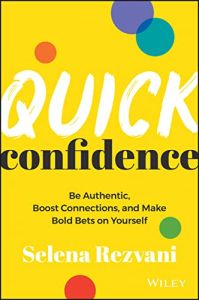Join getAbstract to access the summary!

Join getAbstract to access the summary!
Selena Rezvani
Quick Confidence
Be Authentic, Boost Connections, and Make Bold Bets on Yourself
Wiley, 2023
What's inside?
Use these actionable tips gleaned from thousands of workshops to grow your confidence skills day by day.
Recommendation
Leadership consultant and best-selling author Selena Rezvani offers an array of easily implementable, actionable tips to boost your confidence. Gathered from coaching sessions with thousands of professionals at Microsoft, HP, the World Bank, the US Treasury Department, and many more, these learnable skills fall into three categories: mind-set, embodiment and interpersonal. This comprehensive approach to grow your confidence has already garnered over 90,000 subscribers to Rezvani’s LinkedIn newsletter. Now, collected in one place, they’re ready to put into practice.
Take-Aways
- Take small, daily actions to grow your confidence.
- Leverage first impressions to create authentic connections.
- To belong anywhere, be yourself boldly.
- Use and share power wisely to rebalance inequities in your workplace.
- To avoid overexertion, be decisive, breathe deeply and trust your gut.
- During negotiations, embrace silence and don’t rush decisions.
- In tense situations, visualize success and try to connect with people who have power over you.
- With toxic people and workplaces, protect yourself, create distance and find ways to release stress.
- To overcome setbacks, identify the behaviors that derail you and forgive yourself for them.
- Trust yourself; focus on your own growth rather than others’ opinions.
Summary
Take small, daily actions to grow your confidence.
Everyone faces challenges to their self-confidence. Learning to be bold, take chances and tackle big goals isn’t easy. Boosting your confidence, though, can help you take your ideas and aspirations seriously. You’ll stop discounting your best ideas and have more motivation to pursue them.
“Let’s start growing t0 stand out, rather than shrinking to fit in.”
Small actions to build your confidence can add up to lasting changes. The actions outlined below can help you build the belief that you belong in any situation, can have an impactful presence and can make the most of every opportunity. Confidence is a muscle that can be developed by practicing every day. Build skills in three categories – your mind-set, your physical actions (embodiment) and your interpersonal behavior – to implement a comprehensive confidence-building program.
Leverage first impressions to create authentic connections.
First impressions matter. Use their power to help develop authentic connections wherever you go. Often, people allow their insecurities to drive them, becoming inauthentic and false to themselves in social interactions. But shrinking yourself harms your self-confidence and has negative effects, so show up as yourself.
“Next time you want to make a firm impression in someone’s mind, prioritize your connection with them ahead of dazzling them with your brilliance.”
To improve your mind-set, connect first and lead second. Employees want to connect with leaders before following them. To create a connection, demonstrate genuine warmth and interest. Control your inner dialogue. Repeat affirmations such as “I earned my place here,” and “If it’s meant to be, it’s up to me.”
To embody great first impressions, walk right up and say “hi” to everyone, including those who appear isolated. Dress powerfully – think of something you wore to work that made you feel great. Create five-to-six variations of the outfit to switch out regularly.
In the interpersonal stage, craft your perfect introduction and write it down. Be prepared to describe your work and its impact in simple, understandable terms. Be visible in virtual meetings and set a goal of speaking during them.
To belong anywhere, be yourself boldly.
Belonging to a group often means shrinking your uniqueness to fit in. Unfortunately, that can lead to a watered-down version of your personality. Instead of shrinking, do the opposite: Grow yourself to stand out.
“If your presence doesn’t make an impact, then your absence won’t make a difference.”
Embrace the mind-set that you belong anywhere. Instead of fearing you don’t belong, have a talk with your undermining inner critic. Say to yourself, “I 400% belong here.” Be expansive with your body. Develop habits in your posture and behavior that convey confidence and authority. Straighten your back, maintain eye contact, speak clearly and let your body fully occupy your seat. Accept compliments – lean into them, own and absorb them and say “thank you.” To create interpersonal belonging, explain to others why you’re taking certain actions and ask for their input.
Use and share power wisely to rebalance inequities in your workplace.
Every workplace has power imbalances. To address them, recognize the power dynamics at play and work towards rebalancing them. Help everyone feel they have a voice and belong. In areas where you have power, give strong introductions and nominate overlooked co-workers for great assignments. During meetings, ensure multiple voices have the opportunity to speak, and set limits on overtalkers.
“Don’t overestimate what everyone else can do and underestimate what you can do.”
To embrace a powerful mind-set, stop overapologising, showcase your expertise and find your voice. Eliminate “just,” “sorry to bother you” and “I may be wrong, but” from your vocabulary. Write and memorize a clear explanation of your expertise, your unique approach and mission, and what you seek to accomplish. Tap into your unique story. Avoid the trap of being too modest.
To embody your power, relax your facial expressions and don’t let anyone interrupt you. Practice wearing a neutral expression, neither a smile nor a frown. During interruptions, raise your volume slightly and use gestures to ask the other person to wait. If interruptions continue, make non-judgmental observations about the person’s behavior.
To wield your power interpersonally, don’t allow others to underestimate you. Demonstrate your competence, and deal with aggressive and manipulative co-workers. Push back a bit, use humor to defuse situations, or redirect pushy co-workers to someone else who can help.
To avoid overexertion, be decisive, breathe deeply and trust your gut.
Being overworked can lead to burnout and impaired problem-solving. To avoid overdoing it, aim for a manageable pace of output that doesn’t deplete you. If you’re a high achiever, focus on doing just enough.
“Indecision is a form of decision – and not a strong one. So if your goal is to make bold bets – to step up and lead – indecision won’t be the vehicle to get you there.”
Embrace a decisive mind-set. Practice setting short timers for daily tasks. For example, allow yourself 40 seconds to decide what to wear, then stop thinking about it and get dressed. Connect your daily decisions to a long-term vision, trust your gut and make public commitments to hold yourself accountable.
To use your body’s wisdom to manage unhelpful thoughts, practice the “stop-clap”: Visualize a red stop sign, and clap your hands loudly to help break your negative thought pattern. Also, try box breathing – exhale-hold-inhale-hold for a count of four each.
Don’t overexplain during interpersonal interactions and remove filler words when talking. It drains you and weakens the power of your speech. To avoid it, pause, breathe and answer succinctly. Listen to recordings of yourself to become aware of your “ums” and “ahs.” Then, replace them with a useful transition phrase such as “let’s move on to.”
During negotiations, embrace silence and don’t rush decisions.
Negotiate for what you need rather than settling for what you get. Research shows people who ask for high salaries receive about $5,000 more than those who don’t.
“Very little is written in stone and off-limits. So stop settling for less than optimal and start looking for those powerful win-wins, starting now.”
Embrace a positive mind-set by not assuming your request will be met with a “no.” Overcome expectations of rejection by repeating a simple mantra: “It’s not my job to decide if it’s a no.” Deal with individuals, not their positions of power. If you’re presenting to powerful people, connect with one or two of them. CEOs are people, too.
Use your words – and withhold them – to embody your position. Embrace silence when necessary. Right after you make a request and hear a response, count to seven to collect your thoughts before speaking again. When negotiating a pay raise, ask for the highest offer you can rationally justify. Use research and data to prove your experience, and refer to industry standards.
On an interpersonal level, engage in a respectful dialogue to soften potential resistance. Use the Listen, Affirm, Respond and Ask (LARA) framework. After making a proposal or request, listen to the response, affirm the point of view, respond directly to any concerns and ask questions to deepen the conversation. Don’t rush your decision-making, or apologize for things you haven’t done wrong.
In tense situations, visualize success and try to connect with people who have power over you.
High-stakes moments – those that can make or break your career – are a potent source of anxiety and fear. The challenge is not letting that fear stop you from acting.
“Never underestimate the fact that you shape and mold what’s up for discussion. Speak as a leader. Speak so people listen.”
Embrace the mind-set that everyone makes mistakes, prepare for difficult questions and let people speak for themselves. Instead of obsessively replaying your own mistakes, learn to befriend them. Prepare for unexpected questions and reframe negative ones in a more positive light. Steer conversations towards something you want to speak about. And don’t comment on other people, such as competitors.
To embody success, visualize it happening. Use your five senses to create a mental picture of your ideal outcome. Then shrink it down to the size of a coin, place a real coin in your pocket and carry it wherever you go as a physical reminder. Also, use common gestures to strengthen your argument. Gestures enhance understanding, so use common ones: Count out lists on your fingers, and welcome people with outstretched arms.
In high-stakes interpersonal situations, try to build healthy relationships and think on your feet. Aim for a healthy relationship with your boss. Pay attention to their body language, try to build connection on a personal level and demonstrate your reliability. In tense situations, address what led to the situation, what’s relevant now and what needs to be done in the future.
With toxic people and environments, protect yourself, create distance and find ways to release stress.
Toxic workplaces lower performance and commitment. For individuals, the added negativity can reduce intelligence, memory and immune system function.
“You may not be able to prevent toxic people from coming around. But you can most certainly prevent them from staying.”
To maintain a positive mind-set, don’t match bad energy directed at you, and take the time you need to heal. Try not to mirror the offensive, negative or toxic behavior of others. Although it’s easy to be sucked in, energy matching can weaken your self-respect and well-being in the long term. After leaving a toxic job, take time to unwind and heal (if possible). Write down your personal strengths to boost your confidence, and list “must haves” and “nice to haves” before looking for a new job.
To release difficult feelings from your body, imagine squeezing your stress into a ball and setting it aside. To relieve physical stress, use progressive muscle relaxation: Working on one set of muscles at a time, tighten them for 10 seconds and then release. Remind yourself that most workplace stressors are not matters of life or death.
Set boundaries, distance yourself from toxic people, groups and environments, and find ways to relax. Decide for yourself when to disengage or confront co-workers’ toxic behavior. It’s OK to distance yourself.
To overcome setbacks, identify the behaviors that derail you and forgive yourself for them.
Everyone makes mistakes – the average US worker makes 118 per year. However, not everyone learns from them. Those who do, rise above and move beyond.
“Just because the past didn’t go according to plan doesn’t mean the future can’t be better than you ever imagined.”
To get in the right mind-set to transcend setbacks, identify forces that derail you and forgive yourself. Procrastination, self-protection and perfectionism can impede progress. Focus on one thing you can do right now; think of ways to help yourself feel safe while still making progress; and aim for high-quality (rather than perfect) work. Forgive yourself to move forward and improve your health. Zero in on one big lesson you learned from your misstep.
Engage in actions that help you release feelings of failure from your body. Take five deep breaths and imagine your setback being released on the exhalation. Then, pair this release of the negative with a building up of the positive by doing one task well – something as simple as organizing your desk.
At the interpersonal level, share your mistakes with others, and don’t let yourself be intimidated. Talking to others helps you realize how common failures are. If you feel intimidated by someone, list five things that you and the other person have in common.
Trust yourself; focus on your own growth rather than others’ opinions.
To keep your confidence growing, face your fears and be willing to make mistakes without worrying about perfectionism or being an expert. Your confidence will keep increasing if you set goals, face your fears and maintain a growth mind-set.
“To scale your confidence, you need to take chances, move forward with imperfect information, and bet you will somehow work it out.”
Keep promises to yourself and develop a growth mind-set. Write down your goals, make sure they are fairly realistic, and accept that it takes hard work to follow through. Reframe your mind-set. Instead of thinking, “I’m not good at marketing,” think, “I’m working on getting better at marketing.”
When your brain resists a task, ask your body to do it. For example, if you’re nervous about making a video, ask your body to hit “record.” Learn to manage your emotional, physical, mental and spiritual energy. Build positive emotions, eat well, reduce distractions and live your core values.
Leave the “hedonic treadmill,” and share your stories. Instead of constantly chasing the next experience, slow down, savor positive moments and share them with others.
About the Author
Selena Rezvani is a widely sought leadership speaker and consultant. She’s the author of two other books, including the 2012 bestseller, Pushback: How Smart Women Ask – and Stand Up – for What They Want.
This document is restricted to personal use only.























Comment on this summary